Impact of Leadership Competencies on Sustainability Performance Report
VerifiedAdded on 2022/12/27
|9
|2344
|53
Report
AI Summary
This report delves into the critical role of leadership in enhancing organizational performance and sustainability. It explores various leadership styles, including autocratic, democratic, laissez-faire, and coaching styles, evaluating their pros and cons. The report identifies key leadership competencies such as communication, change management, risk management, and innovation, emphasizing their impact on corporate social responsibility (CSR) and overall business operations. It highlights how effective leadership aligns CSR activities, fosters a positive organizational environment, and motivates employees to achieve organizational goals. The conclusion underscores the importance of selecting suitable leadership approaches to maximize organizational advantages, emphasizing the interconnectedness of leadership, sustainability, and business success.
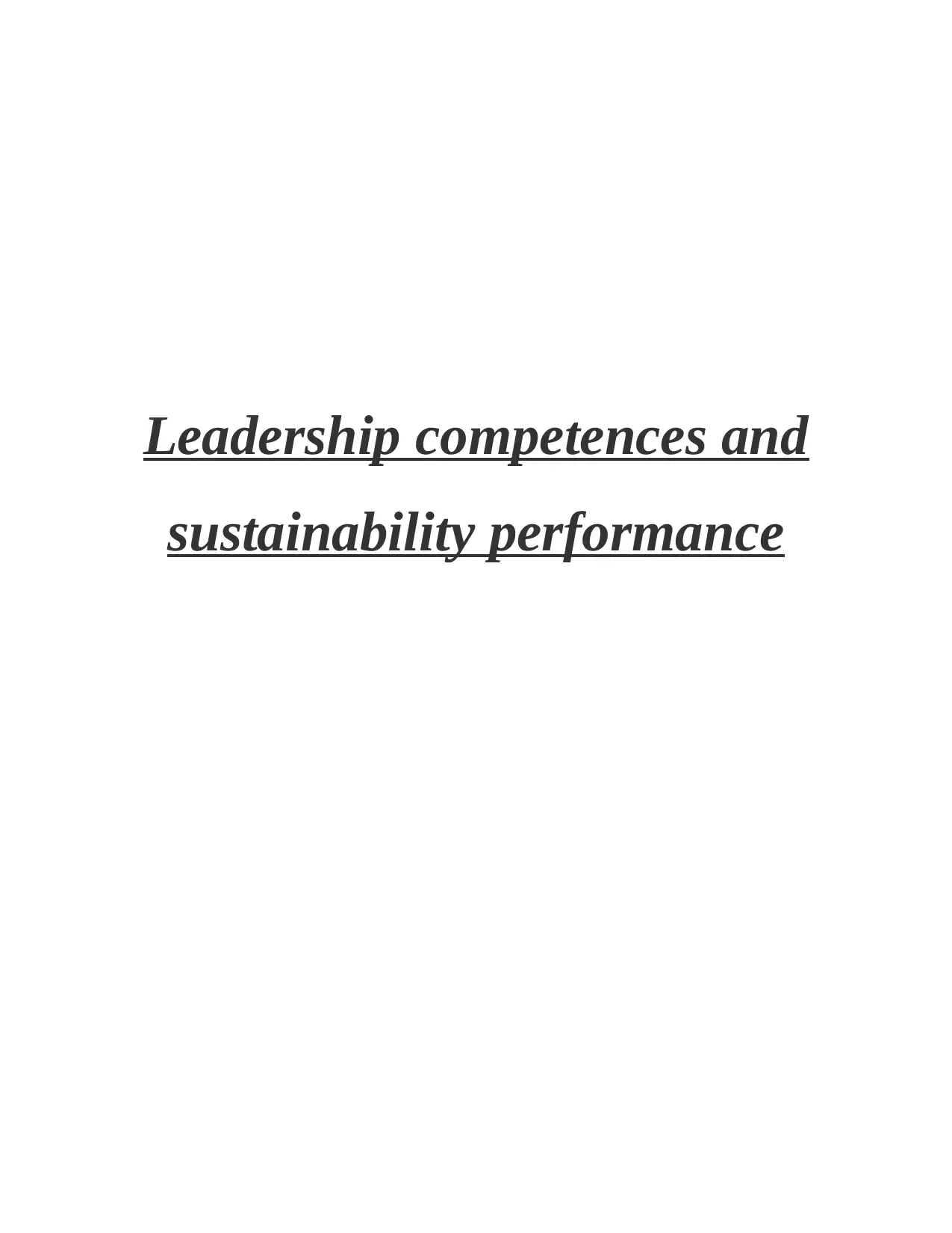
Leadership competences and
sustainability performance
sustainability performance
Paraphrase This Document
Need a fresh take? Get an instant paraphrase of this document with our AI Paraphraser
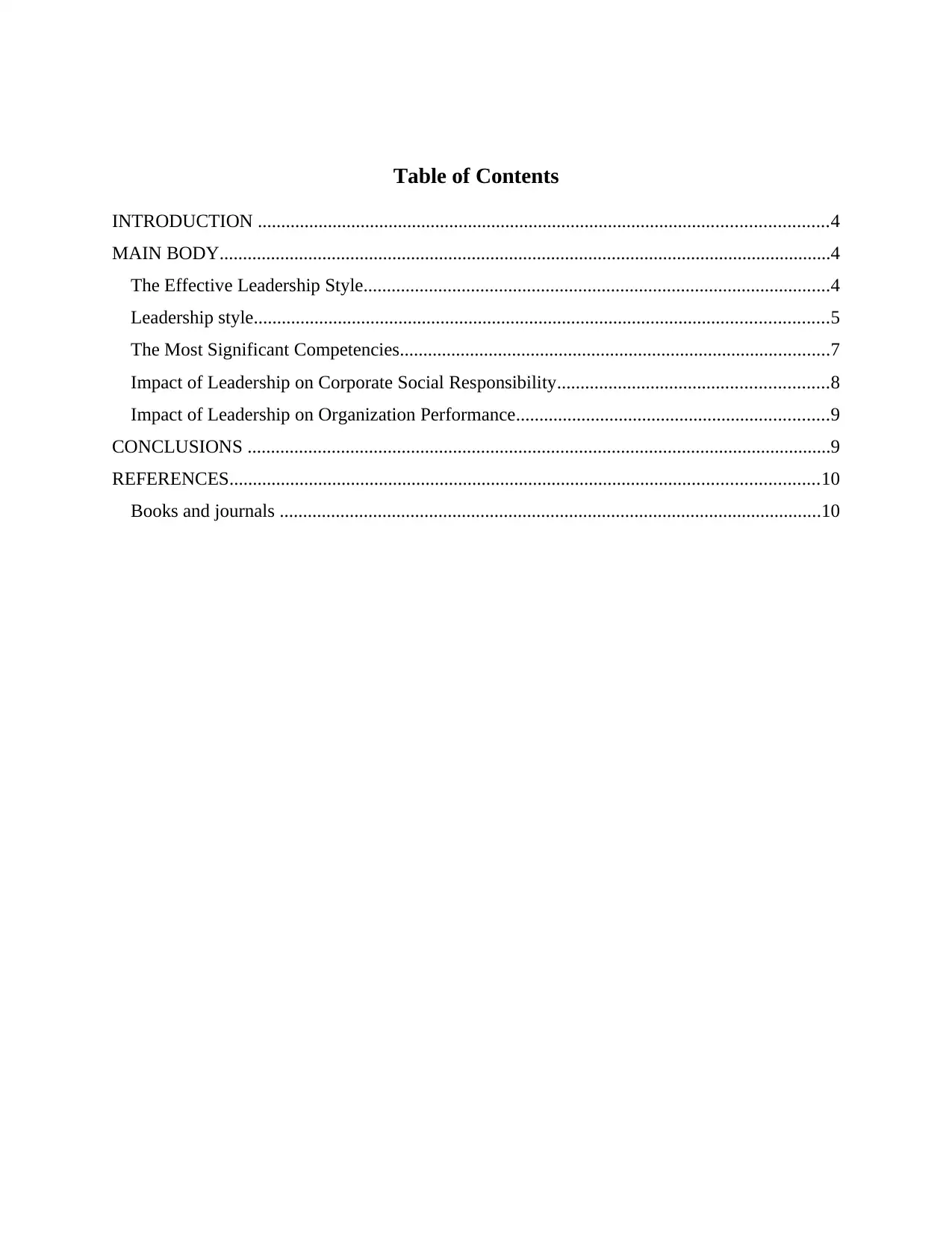
Table of Contents
INTRODUCTION ..........................................................................................................................4
MAIN BODY...................................................................................................................................4
The Effective Leadership Style....................................................................................................4
Leadership style...........................................................................................................................5
The Most Significant Competencies............................................................................................7
Impact of Leadership on Corporate Social Responsibility..........................................................8
Impact of Leadership on Organization Performance...................................................................9
CONCLUSIONS .............................................................................................................................9
REFERENCES..............................................................................................................................10
Books and journals ....................................................................................................................10
INTRODUCTION ..........................................................................................................................4
MAIN BODY...................................................................................................................................4
The Effective Leadership Style....................................................................................................4
Leadership style...........................................................................................................................5
The Most Significant Competencies............................................................................................7
Impact of Leadership on Corporate Social Responsibility..........................................................8
Impact of Leadership on Organization Performance...................................................................9
CONCLUSIONS .............................................................................................................................9
REFERENCES..............................................................................................................................10
Books and journals ....................................................................................................................10
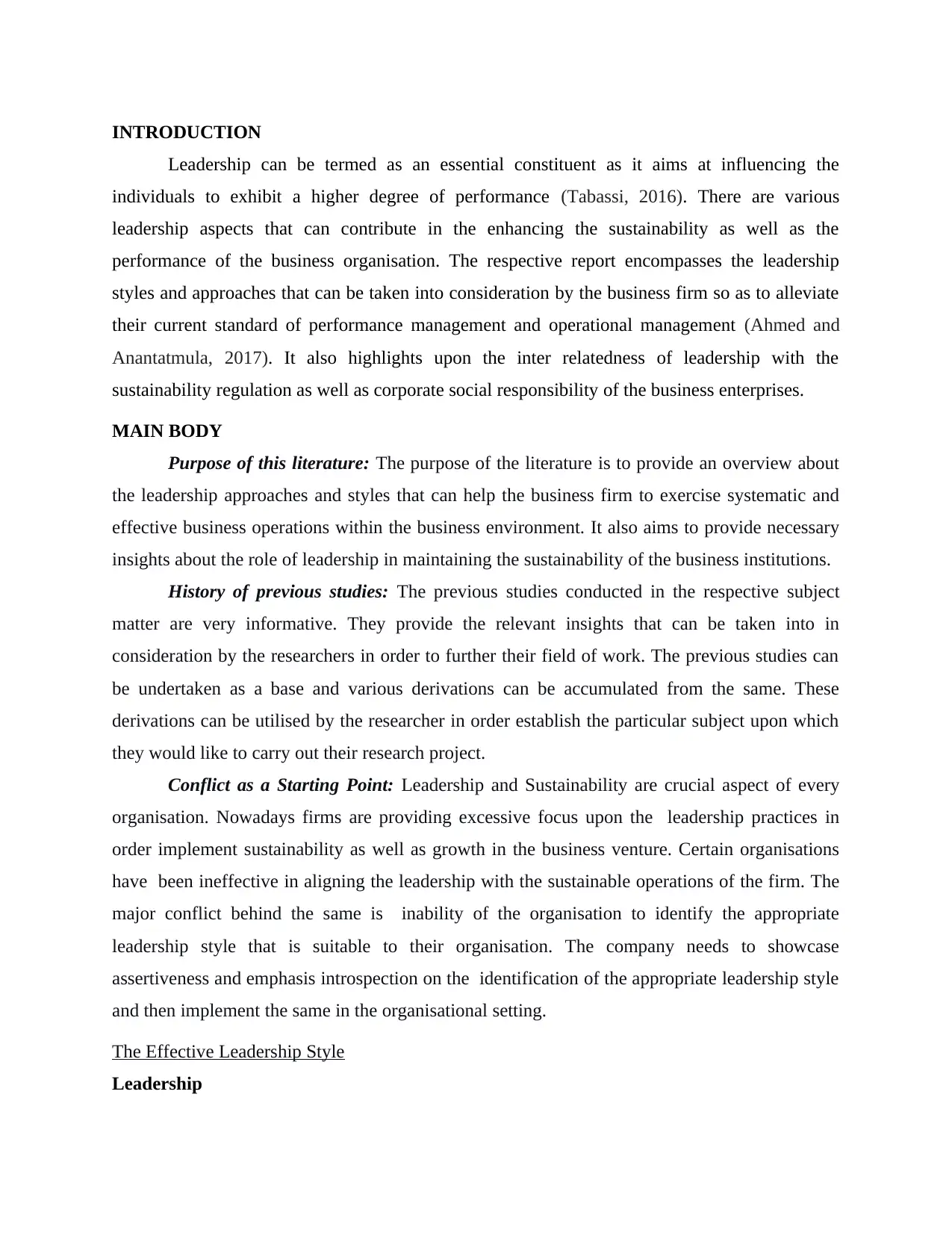
INTRODUCTION
Leadership can be termed as an essential constituent as it aims at influencing the
individuals to exhibit a higher degree of performance (Tabassi, 2016). There are various
leadership aspects that can contribute in the enhancing the sustainability as well as the
performance of the business organisation. The respective report encompasses the leadership
styles and approaches that can be taken into consideration by the business firm so as to alleviate
their current standard of performance management and operational management (Ahmed and
Anantatmula, 2017). It also highlights upon the inter relatedness of leadership with the
sustainability regulation as well as corporate social responsibility of the business enterprises.
MAIN BODY
Purpose of this literature: The purpose of the literature is to provide an overview about
the leadership approaches and styles that can help the business firm to exercise systematic and
effective business operations within the business environment. It also aims to provide necessary
insights about the role of leadership in maintaining the sustainability of the business institutions.
History of previous studies: The previous studies conducted in the respective subject
matter are very informative. They provide the relevant insights that can be taken into in
consideration by the researchers in order to further their field of work. The previous studies can
be undertaken as a base and various derivations can be accumulated from the same. These
derivations can be utilised by the researcher in order establish the particular subject upon which
they would like to carry out their research project.
Conflict as a Starting Point: Leadership and Sustainability are crucial aspect of every
organisation. Nowadays firms are providing excessive focus upon the leadership practices in
order implement sustainability as well as growth in the business venture. Certain organisations
have been ineffective in aligning the leadership with the sustainable operations of the firm. The
major conflict behind the same is inability of the organisation to identify the appropriate
leadership style that is suitable to their organisation. The company needs to showcase
assertiveness and emphasis introspection on the identification of the appropriate leadership style
and then implement the same in the organisational setting.
The Effective Leadership Style
Leadership
Leadership can be termed as an essential constituent as it aims at influencing the
individuals to exhibit a higher degree of performance (Tabassi, 2016). There are various
leadership aspects that can contribute in the enhancing the sustainability as well as the
performance of the business organisation. The respective report encompasses the leadership
styles and approaches that can be taken into consideration by the business firm so as to alleviate
their current standard of performance management and operational management (Ahmed and
Anantatmula, 2017). It also highlights upon the inter relatedness of leadership with the
sustainability regulation as well as corporate social responsibility of the business enterprises.
MAIN BODY
Purpose of this literature: The purpose of the literature is to provide an overview about
the leadership approaches and styles that can help the business firm to exercise systematic and
effective business operations within the business environment. It also aims to provide necessary
insights about the role of leadership in maintaining the sustainability of the business institutions.
History of previous studies: The previous studies conducted in the respective subject
matter are very informative. They provide the relevant insights that can be taken into in
consideration by the researchers in order to further their field of work. The previous studies can
be undertaken as a base and various derivations can be accumulated from the same. These
derivations can be utilised by the researcher in order establish the particular subject upon which
they would like to carry out their research project.
Conflict as a Starting Point: Leadership and Sustainability are crucial aspect of every
organisation. Nowadays firms are providing excessive focus upon the leadership practices in
order implement sustainability as well as growth in the business venture. Certain organisations
have been ineffective in aligning the leadership with the sustainable operations of the firm. The
major conflict behind the same is inability of the organisation to identify the appropriate
leadership style that is suitable to their organisation. The company needs to showcase
assertiveness and emphasis introspection on the identification of the appropriate leadership style
and then implement the same in the organisational setting.
The Effective Leadership Style
Leadership
⊘ This is a preview!⊘
Do you want full access?
Subscribe today to unlock all pages.

Trusted by 1+ million students worldwide
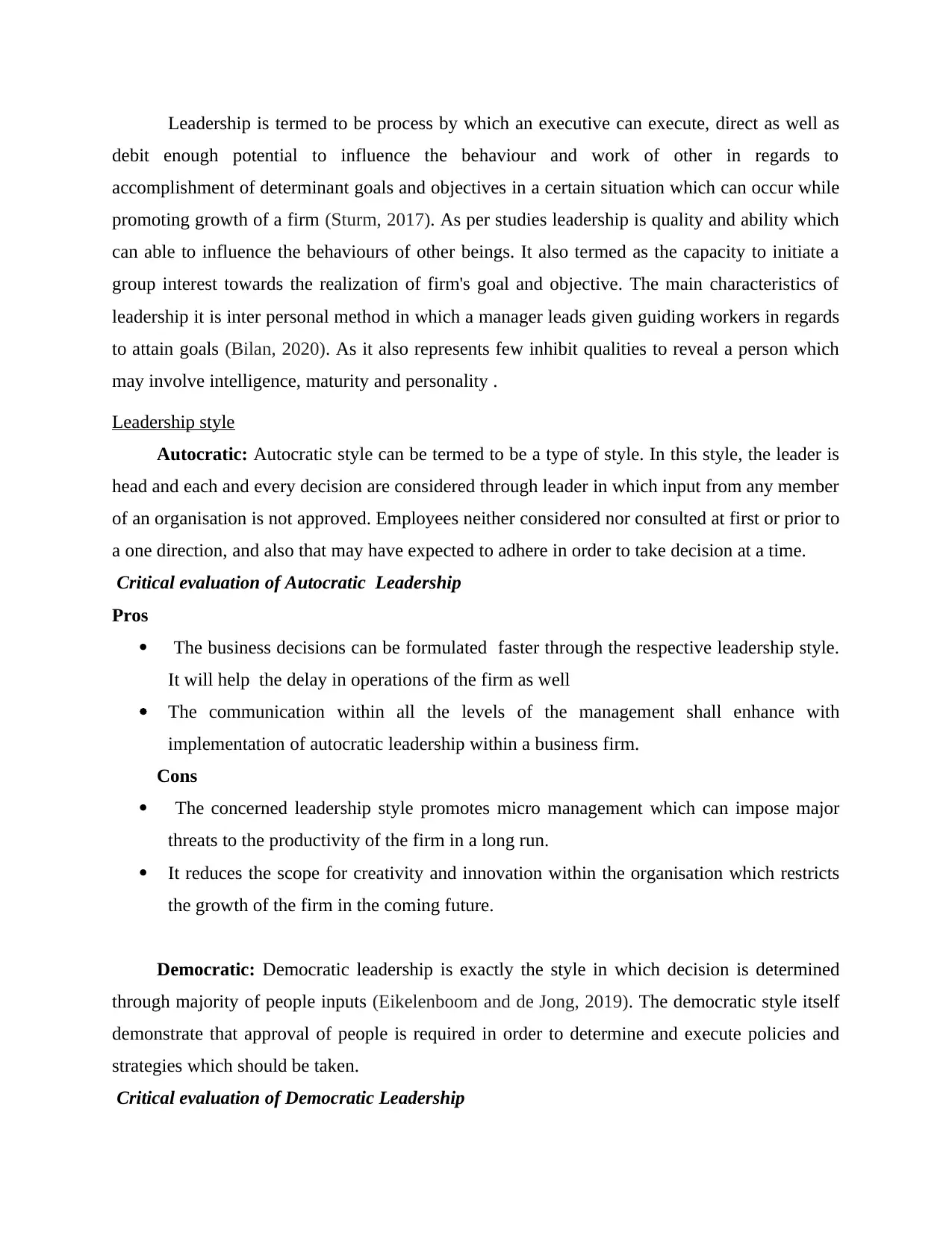
Leadership is termed to be process by which an executive can execute, direct as well as
debit enough potential to influence the behaviour and work of other in regards to
accomplishment of determinant goals and objectives in a certain situation which can occur while
promoting growth of a firm (Sturm, 2017). As per studies leadership is quality and ability which
can able to influence the behaviours of other beings. It also termed as the capacity to initiate a
group interest towards the realization of firm's goal and objective. The main characteristics of
leadership it is inter personal method in which a manager leads given guiding workers in regards
to attain goals (Bilan, 2020). As it also represents few inhibit qualities to reveal a person which
may involve intelligence, maturity and personality .
Leadership style
Autocratic: Autocratic style can be termed to be a type of style. In this style, the leader is
head and each and every decision are considered through leader in which input from any member
of an organisation is not approved. Employees neither considered nor consulted at first or prior to
a one direction, and also that may have expected to adhere in order to take decision at a time.
Critical evaluation of Autocratic Leadership
Pros
The business decisions can be formulated faster through the respective leadership style.
It will help the delay in operations of the firm as well
The communication within all the levels of the management shall enhance with
implementation of autocratic leadership within a business firm.
Cons
The concerned leadership style promotes micro management which can impose major
threats to the productivity of the firm in a long run.
It reduces the scope for creativity and innovation within the organisation which restricts
the growth of the firm in the coming future.
Democratic: Democratic leadership is exactly the style in which decision is determined
through majority of people inputs (Eikelenboom and de Jong, 2019). The democratic style itself
demonstrate that approval of people is required in order to determine and execute policies and
strategies which should be taken.
Critical evaluation of Democratic Leadership
debit enough potential to influence the behaviour and work of other in regards to
accomplishment of determinant goals and objectives in a certain situation which can occur while
promoting growth of a firm (Sturm, 2017). As per studies leadership is quality and ability which
can able to influence the behaviours of other beings. It also termed as the capacity to initiate a
group interest towards the realization of firm's goal and objective. The main characteristics of
leadership it is inter personal method in which a manager leads given guiding workers in regards
to attain goals (Bilan, 2020). As it also represents few inhibit qualities to reveal a person which
may involve intelligence, maturity and personality .
Leadership style
Autocratic: Autocratic style can be termed to be a type of style. In this style, the leader is
head and each and every decision are considered through leader in which input from any member
of an organisation is not approved. Employees neither considered nor consulted at first or prior to
a one direction, and also that may have expected to adhere in order to take decision at a time.
Critical evaluation of Autocratic Leadership
Pros
The business decisions can be formulated faster through the respective leadership style.
It will help the delay in operations of the firm as well
The communication within all the levels of the management shall enhance with
implementation of autocratic leadership within a business firm.
Cons
The concerned leadership style promotes micro management which can impose major
threats to the productivity of the firm in a long run.
It reduces the scope for creativity and innovation within the organisation which restricts
the growth of the firm in the coming future.
Democratic: Democratic leadership is exactly the style in which decision is determined
through majority of people inputs (Eikelenboom and de Jong, 2019). The democratic style itself
demonstrate that approval of people is required in order to determine and execute policies and
strategies which should be taken.
Critical evaluation of Democratic Leadership
Paraphrase This Document
Need a fresh take? Get an instant paraphrase of this document with our AI Paraphraser
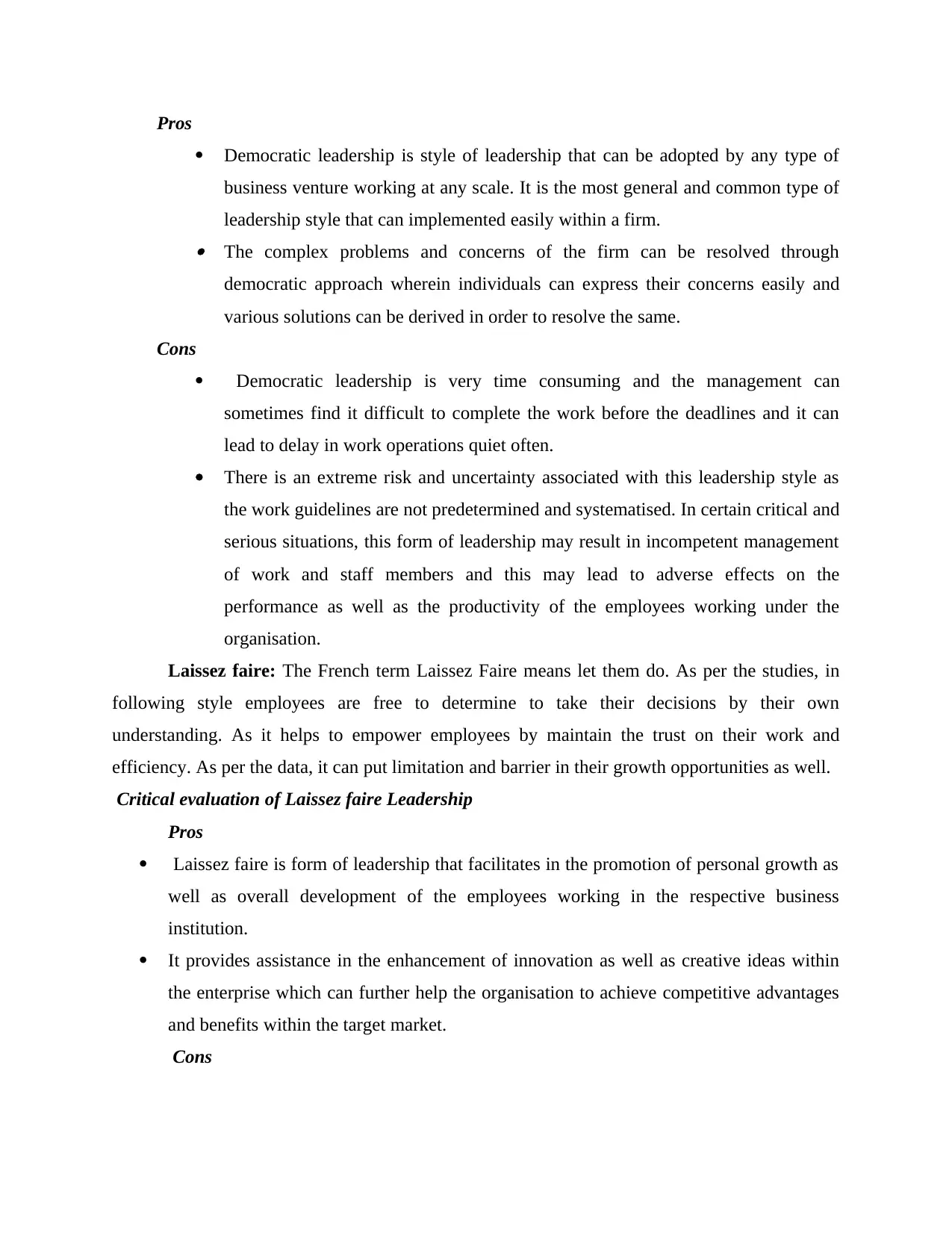
Pros
Democratic leadership is style of leadership that can be adopted by any type of
business venture working at any scale. It is the most general and common type of
leadership style that can implemented easily within a firm.
The complex problems and concerns of the firm can be resolved through
democratic approach wherein individuals can express their concerns easily and
various solutions can be derived in order to resolve the same.
Cons
Democratic leadership is very time consuming and the management can
sometimes find it difficult to complete the work before the deadlines and it can
lead to delay in work operations quiet often.
There is an extreme risk and uncertainty associated with this leadership style as
the work guidelines are not predetermined and systematised. In certain critical and
serious situations, this form of leadership may result in incompetent management
of work and staff members and this may lead to adverse effects on the
performance as well as the productivity of the employees working under the
organisation.
Laissez faire: The French term Laissez Faire means let them do. As per the studies, in
following style employees are free to determine to take their decisions by their own
understanding. As it helps to empower employees by maintain the trust on their work and
efficiency. As per the data, it can put limitation and barrier in their growth opportunities as well.
Critical evaluation of Laissez faire Leadership
Pros
Laissez faire is form of leadership that facilitates in the promotion of personal growth as
well as overall development of the employees working in the respective business
institution.
It provides assistance in the enhancement of innovation as well as creative ideas within
the enterprise which can further help the organisation to achieve competitive advantages
and benefits within the target market.
Cons
Democratic leadership is style of leadership that can be adopted by any type of
business venture working at any scale. It is the most general and common type of
leadership style that can implemented easily within a firm.
The complex problems and concerns of the firm can be resolved through
democratic approach wherein individuals can express their concerns easily and
various solutions can be derived in order to resolve the same.
Cons
Democratic leadership is very time consuming and the management can
sometimes find it difficult to complete the work before the deadlines and it can
lead to delay in work operations quiet often.
There is an extreme risk and uncertainty associated with this leadership style as
the work guidelines are not predetermined and systematised. In certain critical and
serious situations, this form of leadership may result in incompetent management
of work and staff members and this may lead to adverse effects on the
performance as well as the productivity of the employees working under the
organisation.
Laissez faire: The French term Laissez Faire means let them do. As per the studies, in
following style employees are free to determine to take their decisions by their own
understanding. As it helps to empower employees by maintain the trust on their work and
efficiency. As per the data, it can put limitation and barrier in their growth opportunities as well.
Critical evaluation of Laissez faire Leadership
Pros
Laissez faire is form of leadership that facilitates in the promotion of personal growth as
well as overall development of the employees working in the respective business
institution.
It provides assistance in the enhancement of innovation as well as creative ideas within
the enterprise which can further help the organisation to achieve competitive advantages
and benefits within the target market.
Cons
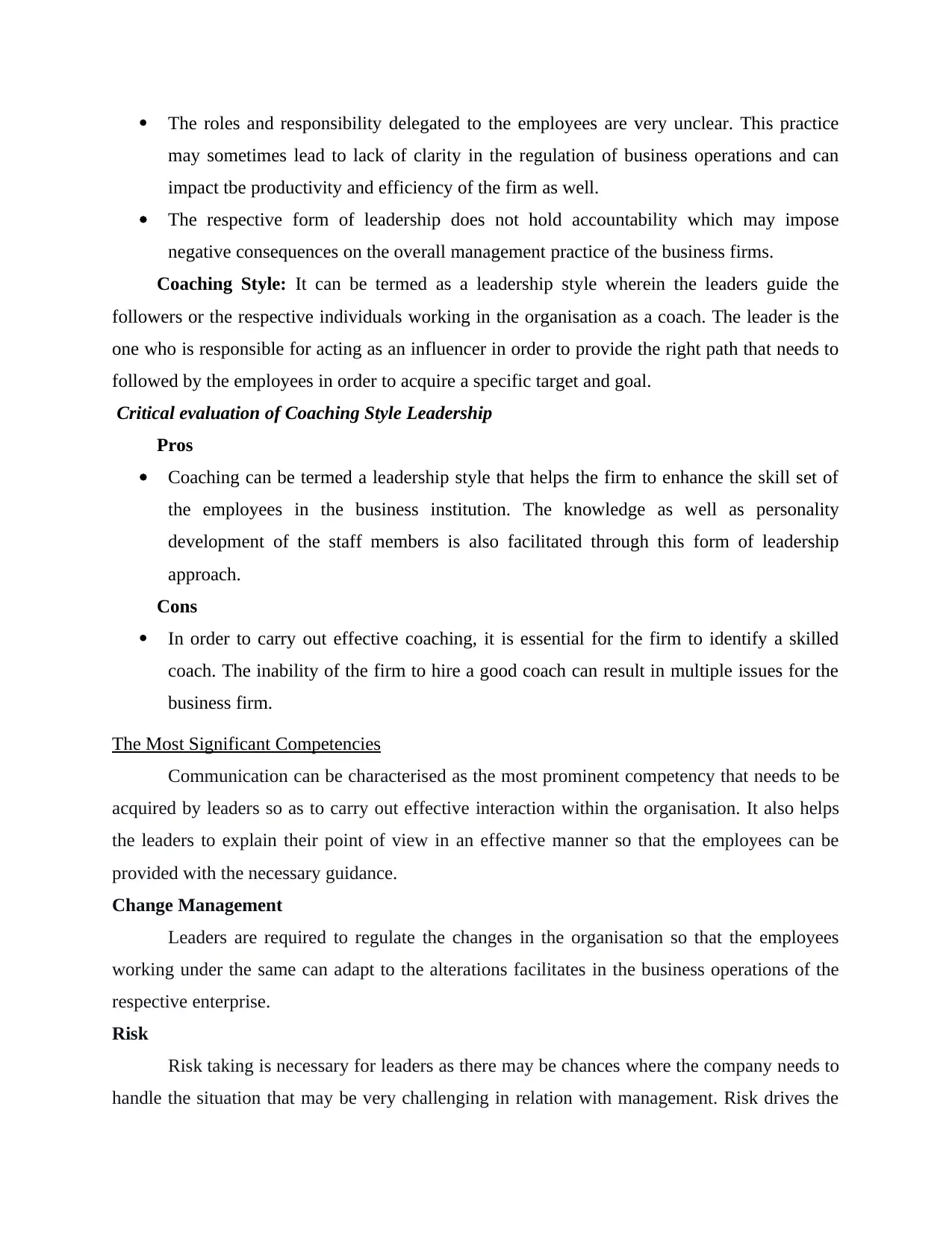
The roles and responsibility delegated to the employees are very unclear. This practice
may sometimes lead to lack of clarity in the regulation of business operations and can
impact tbe productivity and efficiency of the firm as well.
The respective form of leadership does not hold accountability which may impose
negative consequences on the overall management practice of the business firms.
Coaching Style: It can be termed as a leadership style wherein the leaders guide the
followers or the respective individuals working in the organisation as a coach. The leader is the
one who is responsible for acting as an influencer in order to provide the right path that needs to
followed by the employees in order to acquire a specific target and goal.
Critical evaluation of Coaching Style Leadership
Pros
Coaching can be termed a leadership style that helps the firm to enhance the skill set of
the employees in the business institution. The knowledge as well as personality
development of the staff members is also facilitated through this form of leadership
approach.
Cons
In order to carry out effective coaching, it is essential for the firm to identify a skilled
coach. The inability of the firm to hire a good coach can result in multiple issues for the
business firm.
The Most Significant Competencies
Communication can be characterised as the most prominent competency that needs to be
acquired by leaders so as to carry out effective interaction within the organisation. It also helps
the leaders to explain their point of view in an effective manner so that the employees can be
provided with the necessary guidance.
Change Management
Leaders are required to regulate the changes in the organisation so that the employees
working under the same can adapt to the alterations facilitates in the business operations of the
respective enterprise.
Risk
Risk taking is necessary for leaders as there may be chances where the company needs to
handle the situation that may be very challenging in relation with management. Risk drives the
may sometimes lead to lack of clarity in the regulation of business operations and can
impact tbe productivity and efficiency of the firm as well.
The respective form of leadership does not hold accountability which may impose
negative consequences on the overall management practice of the business firms.
Coaching Style: It can be termed as a leadership style wherein the leaders guide the
followers or the respective individuals working in the organisation as a coach. The leader is the
one who is responsible for acting as an influencer in order to provide the right path that needs to
followed by the employees in order to acquire a specific target and goal.
Critical evaluation of Coaching Style Leadership
Pros
Coaching can be termed a leadership style that helps the firm to enhance the skill set of
the employees in the business institution. The knowledge as well as personality
development of the staff members is also facilitated through this form of leadership
approach.
Cons
In order to carry out effective coaching, it is essential for the firm to identify a skilled
coach. The inability of the firm to hire a good coach can result in multiple issues for the
business firm.
The Most Significant Competencies
Communication can be characterised as the most prominent competency that needs to be
acquired by leaders so as to carry out effective interaction within the organisation. It also helps
the leaders to explain their point of view in an effective manner so that the employees can be
provided with the necessary guidance.
Change Management
Leaders are required to regulate the changes in the organisation so that the employees
working under the same can adapt to the alterations facilitates in the business operations of the
respective enterprise.
Risk
Risk taking is necessary for leaders as there may be chances where the company needs to
handle the situation that may be very challenging in relation with management. Risk drives the
⊘ This is a preview!⊘
Do you want full access?
Subscribe today to unlock all pages.

Trusted by 1+ million students worldwide
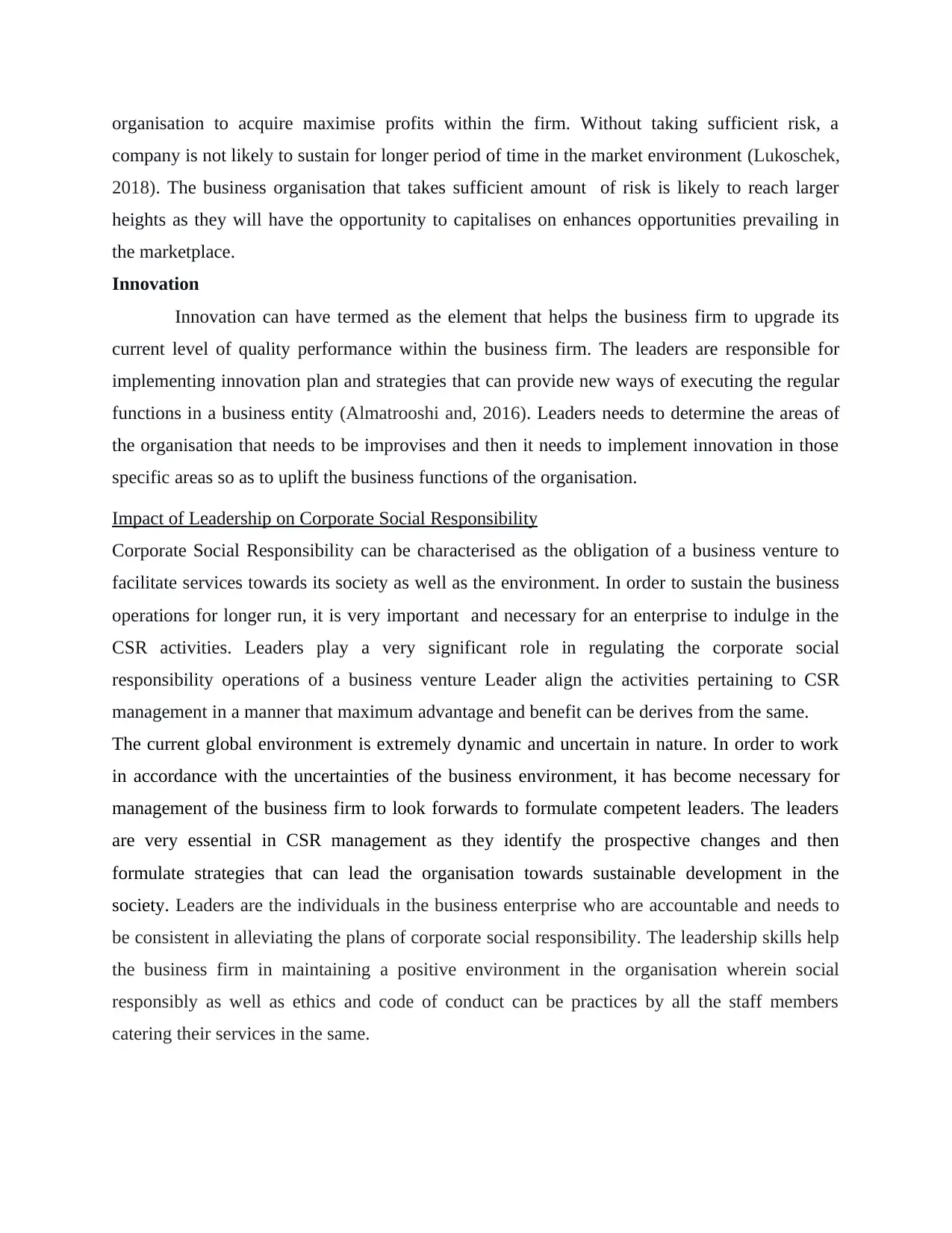
organisation to acquire maximise profits within the firm. Without taking sufficient risk, a
company is not likely to sustain for longer period of time in the market environment (Lukoschek,
2018). The business organisation that takes sufficient amount of risk is likely to reach larger
heights as they will have the opportunity to capitalises on enhances opportunities prevailing in
the marketplace.
Innovation
Innovation can have termed as the element that helps the business firm to upgrade its
current level of quality performance within the business firm. The leaders are responsible for
implementing innovation plan and strategies that can provide new ways of executing the regular
functions in a business entity (Almatrooshi and, 2016). Leaders needs to determine the areas of
the organisation that needs to be improvises and then it needs to implement innovation in those
specific areas so as to uplift the business functions of the organisation.
Impact of Leadership on Corporate Social Responsibility
Corporate Social Responsibility can be characterised as the obligation of a business venture to
facilitate services towards its society as well as the environment. In order to sustain the business
operations for longer run, it is very important and necessary for an enterprise to indulge in the
CSR activities. Leaders play a very significant role in regulating the corporate social
responsibility operations of a business venture Leader align the activities pertaining to CSR
management in a manner that maximum advantage and benefit can be derives from the same.
The current global environment is extremely dynamic and uncertain in nature. In order to work
in accordance with the uncertainties of the business environment, it has become necessary for
management of the business firm to look forwards to formulate competent leaders. The leaders
are very essential in CSR management as they identify the prospective changes and then
formulate strategies that can lead the organisation towards sustainable development in the
society. Leaders are the individuals in the business enterprise who are accountable and needs to
be consistent in alleviating the plans of corporate social responsibility. The leadership skills help
the business firm in maintaining a positive environment in the organisation wherein social
responsibly as well as ethics and code of conduct can be practices by all the staff members
catering their services in the same.
company is not likely to sustain for longer period of time in the market environment (Lukoschek,
2018). The business organisation that takes sufficient amount of risk is likely to reach larger
heights as they will have the opportunity to capitalises on enhances opportunities prevailing in
the marketplace.
Innovation
Innovation can have termed as the element that helps the business firm to upgrade its
current level of quality performance within the business firm. The leaders are responsible for
implementing innovation plan and strategies that can provide new ways of executing the regular
functions in a business entity (Almatrooshi and, 2016). Leaders needs to determine the areas of
the organisation that needs to be improvises and then it needs to implement innovation in those
specific areas so as to uplift the business functions of the organisation.
Impact of Leadership on Corporate Social Responsibility
Corporate Social Responsibility can be characterised as the obligation of a business venture to
facilitate services towards its society as well as the environment. In order to sustain the business
operations for longer run, it is very important and necessary for an enterprise to indulge in the
CSR activities. Leaders play a very significant role in regulating the corporate social
responsibility operations of a business venture Leader align the activities pertaining to CSR
management in a manner that maximum advantage and benefit can be derives from the same.
The current global environment is extremely dynamic and uncertain in nature. In order to work
in accordance with the uncertainties of the business environment, it has become necessary for
management of the business firm to look forwards to formulate competent leaders. The leaders
are very essential in CSR management as they identify the prospective changes and then
formulate strategies that can lead the organisation towards sustainable development in the
society. Leaders are the individuals in the business enterprise who are accountable and needs to
be consistent in alleviating the plans of corporate social responsibility. The leadership skills help
the business firm in maintaining a positive environment in the organisation wherein social
responsibly as well as ethics and code of conduct can be practices by all the staff members
catering their services in the same.
Paraphrase This Document
Need a fresh take? Get an instant paraphrase of this document with our AI Paraphraser
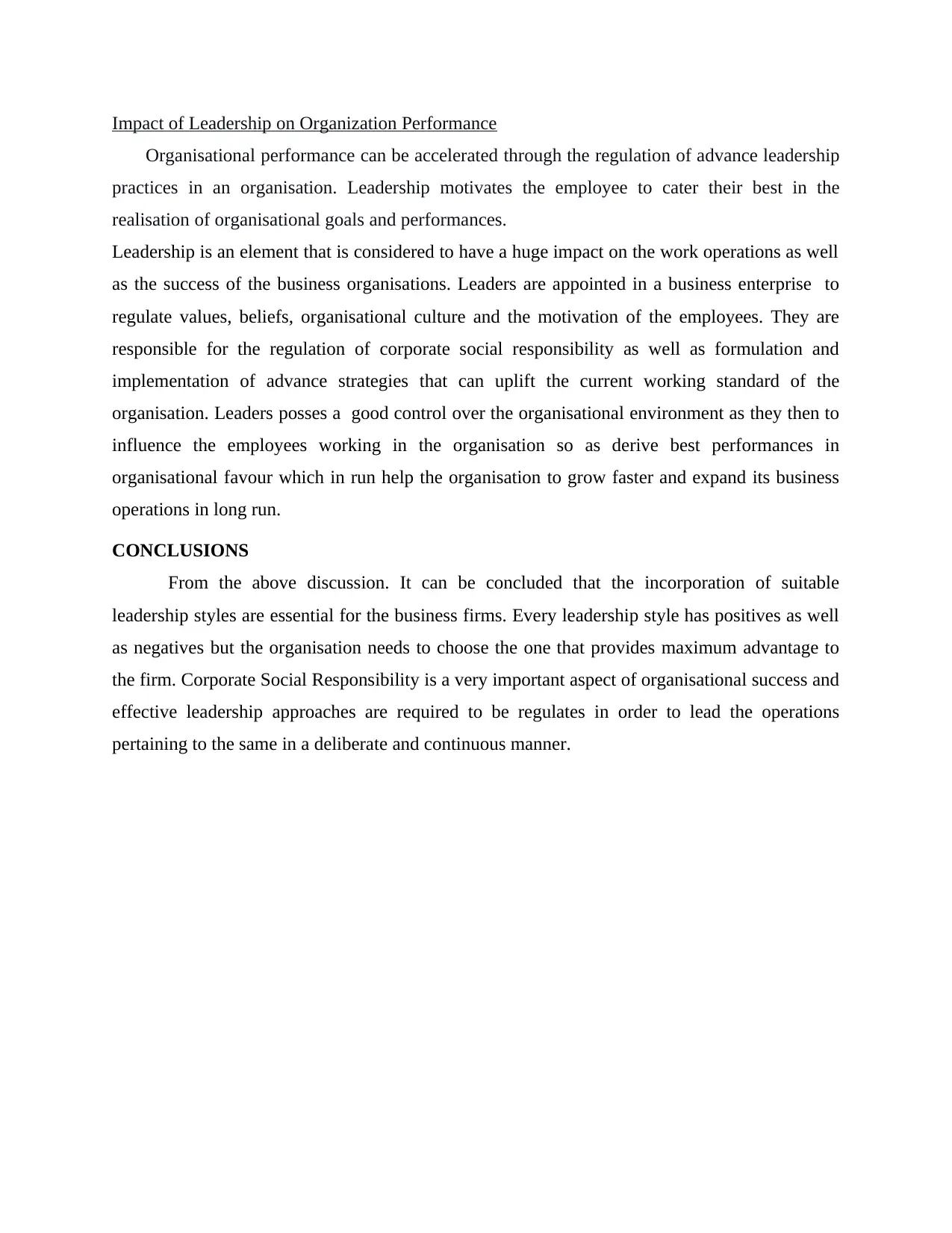
Impact of Leadership on Organization Performance
Organisational performance can be accelerated through the regulation of advance leadership
practices in an organisation. Leadership motivates the employee to cater their best in the
realisation of organisational goals and performances.
Leadership is an element that is considered to have a huge impact on the work operations as well
as the success of the business organisations. Leaders are appointed in a business enterprise to
regulate values, beliefs, organisational culture and the motivation of the employees. They are
responsible for the regulation of corporate social responsibility as well as formulation and
implementation of advance strategies that can uplift the current working standard of the
organisation. Leaders posses a good control over the organisational environment as they then to
influence the employees working in the organisation so as derive best performances in
organisational favour which in run help the organisation to grow faster and expand its business
operations in long run.
CONCLUSIONS
From the above discussion. It can be concluded that the incorporation of suitable
leadership styles are essential for the business firms. Every leadership style has positives as well
as negatives but the organisation needs to choose the one that provides maximum advantage to
the firm. Corporate Social Responsibility is a very important aspect of organisational success and
effective leadership approaches are required to be regulates in order to lead the operations
pertaining to the same in a deliberate and continuous manner.
Organisational performance can be accelerated through the regulation of advance leadership
practices in an organisation. Leadership motivates the employee to cater their best in the
realisation of organisational goals and performances.
Leadership is an element that is considered to have a huge impact on the work operations as well
as the success of the business organisations. Leaders are appointed in a business enterprise to
regulate values, beliefs, organisational culture and the motivation of the employees. They are
responsible for the regulation of corporate social responsibility as well as formulation and
implementation of advance strategies that can uplift the current working standard of the
organisation. Leaders posses a good control over the organisational environment as they then to
influence the employees working in the organisation so as derive best performances in
organisational favour which in run help the organisation to grow faster and expand its business
operations in long run.
CONCLUSIONS
From the above discussion. It can be concluded that the incorporation of suitable
leadership styles are essential for the business firms. Every leadership style has positives as well
as negatives but the organisation needs to choose the one that provides maximum advantage to
the firm. Corporate Social Responsibility is a very important aspect of organisational success and
effective leadership approaches are required to be regulates in order to lead the operations
pertaining to the same in a deliberate and continuous manner.
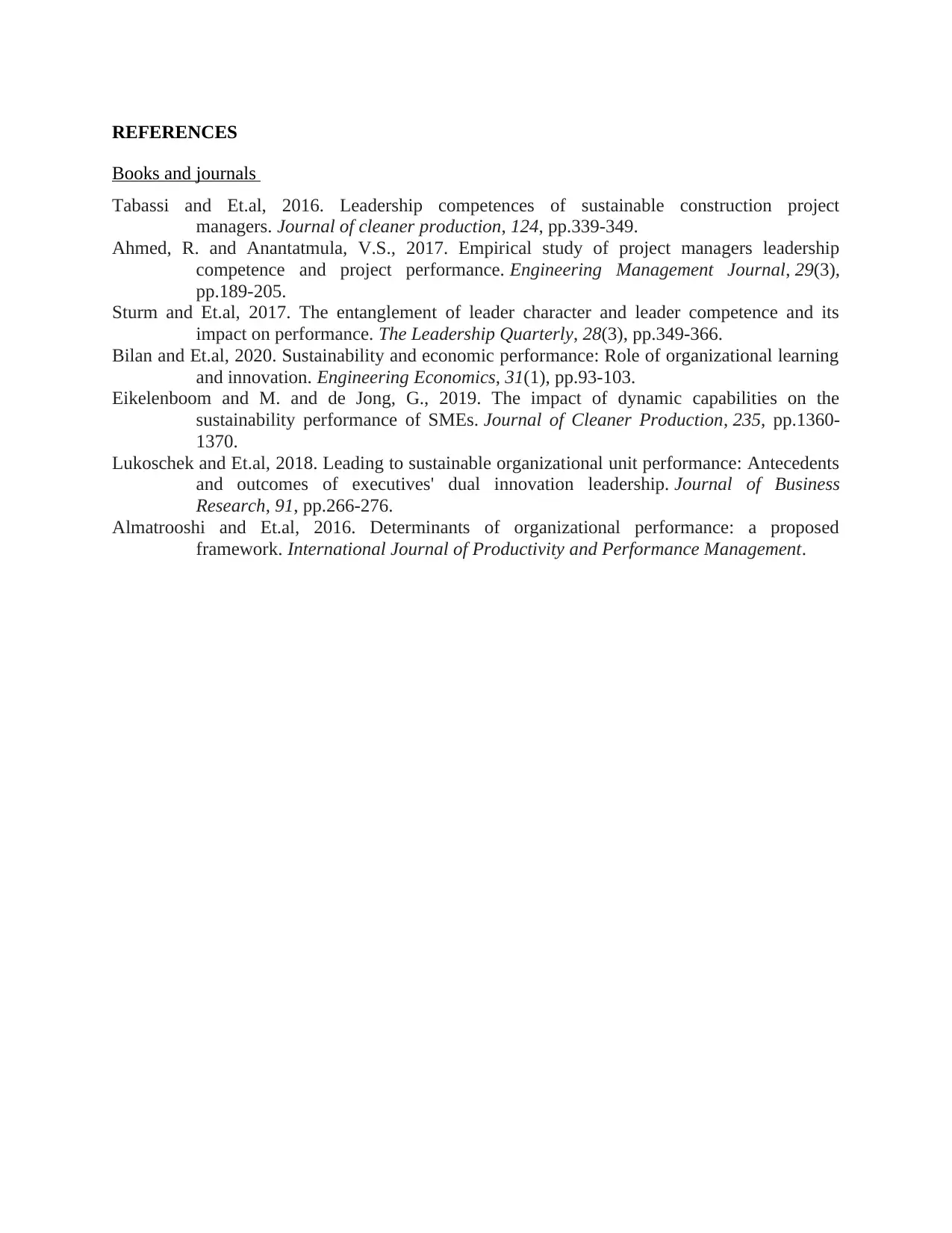
REFERENCES
Books and journals
Tabassi and Et.al, 2016. Leadership competences of sustainable construction project
managers. Journal of cleaner production, 124, pp.339-349.
Ahmed, R. and Anantatmula, V.S., 2017. Empirical study of project managers leadership
competence and project performance. Engineering Management Journal, 29(3),
pp.189-205.
Sturm and Et.al, 2017. The entanglement of leader character and leader competence and its
impact on performance. The Leadership Quarterly, 28(3), pp.349-366.
Bilan and Et.al, 2020. Sustainability and economic performance: Role of organizational learning
and innovation. Engineering Economics, 31(1), pp.93-103.
Eikelenboom and M. and de Jong, G., 2019. The impact of dynamic capabilities on the
sustainability performance of SMEs. Journal of Cleaner Production, 235, pp.1360-
1370.
Lukoschek and Et.al, 2018. Leading to sustainable organizational unit performance: Antecedents
and outcomes of executives' dual innovation leadership. Journal of Business
Research, 91, pp.266-276.
Almatrooshi and Et.al, 2016. Determinants of organizational performance: a proposed
framework. International Journal of Productivity and Performance Management.
Books and journals
Tabassi and Et.al, 2016. Leadership competences of sustainable construction project
managers. Journal of cleaner production, 124, pp.339-349.
Ahmed, R. and Anantatmula, V.S., 2017. Empirical study of project managers leadership
competence and project performance. Engineering Management Journal, 29(3),
pp.189-205.
Sturm and Et.al, 2017. The entanglement of leader character and leader competence and its
impact on performance. The Leadership Quarterly, 28(3), pp.349-366.
Bilan and Et.al, 2020. Sustainability and economic performance: Role of organizational learning
and innovation. Engineering Economics, 31(1), pp.93-103.
Eikelenboom and M. and de Jong, G., 2019. The impact of dynamic capabilities on the
sustainability performance of SMEs. Journal of Cleaner Production, 235, pp.1360-
1370.
Lukoschek and Et.al, 2018. Leading to sustainable organizational unit performance: Antecedents
and outcomes of executives' dual innovation leadership. Journal of Business
Research, 91, pp.266-276.
Almatrooshi and Et.al, 2016. Determinants of organizational performance: a proposed
framework. International Journal of Productivity and Performance Management.
⊘ This is a preview!⊘
Do you want full access?
Subscribe today to unlock all pages.

Trusted by 1+ million students worldwide
1 out of 9
Related Documents
Your All-in-One AI-Powered Toolkit for Academic Success.
+13062052269
info@desklib.com
Available 24*7 on WhatsApp / Email
![[object Object]](/_next/static/media/star-bottom.7253800d.svg)
Unlock your academic potential
Copyright © 2020–2025 A2Z Services. All Rights Reserved. Developed and managed by ZUCOL.





